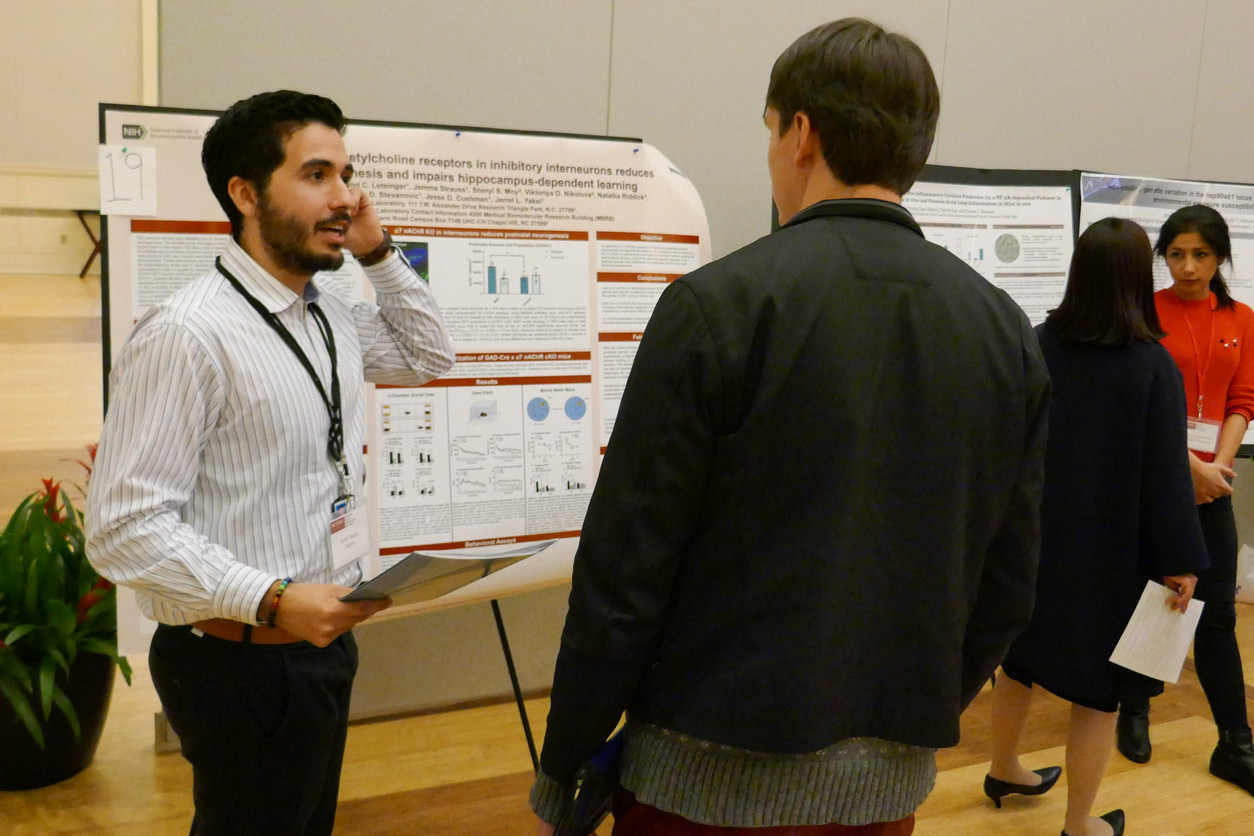The NIEHS-funded Center for Human Health and the Environment (CHHE) at North Carolina State University (NCSU) held its fourth annual science symposium, “Interactions Between the Brain and the Environment,” on Feb. 20. Academic researchers, government scientists, postdoctoral trainees, and undergraduate and graduate students met to listen, learn, and share their latest findings.
Too many chemicals, not enough time
 “It can take a decade for a pesticide to be proved developmentally neurotoxic, and in the interim, you have susceptible populations exposed,” said Behl. (Photo courtesy of Jesse Saffron)
“It can take a decade for a pesticide to be proved developmentally neurotoxic, and in the interim, you have susceptible populations exposed,” said Behl. (Photo courtesy of Jesse Saffron)“There’s been a staggering rise in neurodevelopmental disorders in the United States and globally,” noted National Toxicology Program (NTP) Toxicologist Mamta Behl, Ph.D., during her keynote talk. “At NTP, we’re asking what could be some environmental causes.”
She cited evidence showing increased prevalence of conditions such as attention-deficit hyperactivity disorder (ADHD) and autism spectrum disorder. And she drew attention to industrial and commercial chemicals, such as pesticides and flame retardants.
“There are tens of thousands of compounds in our environment that remain untested,” she explained. “Kids and pregnant women are exposed, and this is really an issue.”
Traditional animal studies can be costly, time-consuming, and, given the number of chemicals on the market, impractical. So, there is demand for better tools to analyze such substances, according to Behl.
A new direction
“NTP recently created a Developmental Neurotoxicity Health Effects Innovation program, recognizing the need for a new framework to evaluate chemicals with potential neurodevelopmental effects,” she said.
One goal is to rapidly rank compounds for in-depth testing. For this, researchers can use screening approaches such as cell models or animal models that use zebrafish or other alternatives to rodent tests.
 Renowned epigenetics expert Randy Jirtle, Ph.D., from NCSU, was an active participant during the symposium. (Photo courtesy of Jesse Saffron)
Renowned epigenetics expert Randy Jirtle, Ph.D., from NCSU, was an active participant during the symposium. (Photo courtesy of Jesse Saffron)The program aims to foster collaboration and data-sharing among toxicologists in the United States and abroad, and train young scientists in the new methods. Behl said she is especially interested in working more with healthcare providers.
“Right now, there’s not much communication,” she said. “We are trying to change that by understanding the concerns in the clinic and how we might be able to help in translating the research.”
Early-life exposure to air pollution, BPA
CHHE’s symposium featured nine other speakers and 24 poster presentations. Some topics covered included the following:
- How environmental factors may contribute to amyotrophic lateral sclerosis, or ALS.
- Developmental exposure to air pollution and maternal stress.
- Flame retardants and socioemotional behavior.
 NCSU epidemiologist Cathrine Hoyo, Ph.D., discussed epigenetic changes associated with Alzheimer’s disease. (Photo courtesy of Jesse Saffron)
NCSU epidemiologist Cathrine Hoyo, Ph.D., discussed epigenetic changes associated with Alzheimer’s disease. (Photo courtesy of Jesse Saffron)NIEHS grantee Janice Juraska, Ph.D., from the University of Illinois, gave a keynote talk about her work looking at effects of bisphenol A (BPA) and phthalates, which are chemicals found in many plastics, on the medial prefrontal cortex.
“In humans, [that area of the brain] is incredibly important for just about every neurobehavioral problem that exists,” said Juraska.
Take autism as an example. In young males with the disorder, the medial prefrontal cortex shows an increase in neurons. Juraska’s team found that in male rats, developmental exposure to BPA resulted in such an uptick. However, she made clear that she was not linking the chemical to autism — more work on the underlying biological mechanisms is needed.
On the frontier
Patricia Jensen, Ph.D., head of the NIEHS Developmental Neurobiology Group, closed the meeting.
 Last year, the National Institutes of Health awarded Jensen tenure by unanimous vote. Check out this Environmental Factor story to learn more about her research. (Photo courtesy of Jesse Saffron)
Last year, the National Institutes of Health awarded Jensen tenure by unanimous vote. Check out this Environmental Factor story to learn more about her research. (Photo courtesy of Jesse Saffron)“My lab is focused on the central noradrenergic system — the cells within the brain and the peripheral nervous system that actively synthesize norepinephrine,” said Jensen.
Noradrenergic neurons release norepinephrine in brain areas affecting attention, learning, sleep, and other key functions. Jensen discussed the locus coeruleus, an important part of the central noradrenergic system.
“One of the big questions we have is what are the long-term effects of altered locus coeruleus norepinephrine signaling during development,” she said.
So far, her lab has found that in male mice, early loss of such signaling results in seizures, reduced sociability, learning deficits, and other traits related to developmental disorders. Going forward, Jensen will examine chlorpyrifos, a common pesticide. Her goal is to determine whether early exposure to chlorpyrifos causes long-term changes in the function of noradrenergic neurons in the locus coeruleus.
 Samir Nacer, a postbaccalaureate fellow in the NIEHS Neurobehavioral Core Laboratory, answered questions about his latest research. (Photo courtesy of Jesse Saffron)
Samir Nacer, a postbaccalaureate fellow in the NIEHS Neurobehavioral Core Laboratory, answered questions about his latest research. (Photo courtesy of Jesse Saffron)“This is one of the most important research frontiers in environmental health — to understand how environmental stressors affect brain development and function, and result in cognitive, neurodegenerative, and behavioral outcomes,” CHHE Director Rob Smart, Ph.D., told attendees.
(Jesse Saffron, J.D., is a technical writer-editor in the NIEHS Office of Communications and Public Liaison.)









